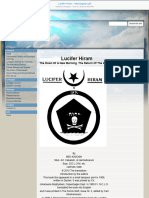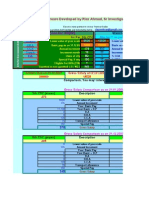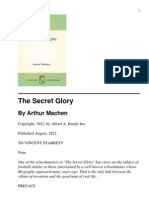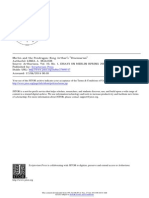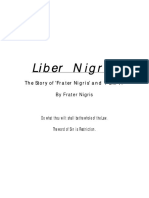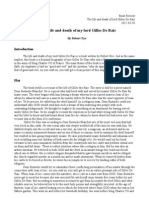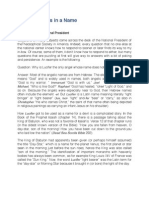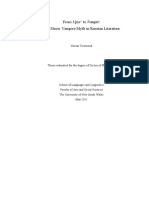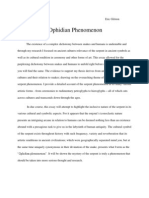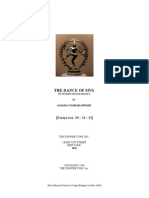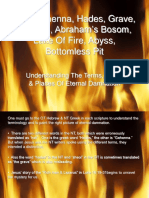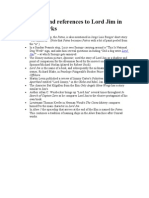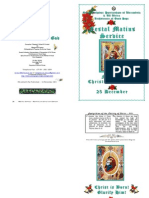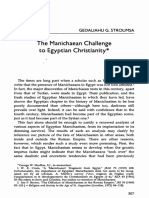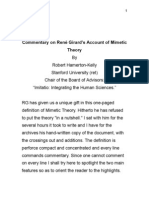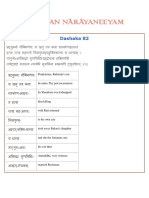A More Poetical Character Than Satan
A More Poetical Character Than Satan
Uploaded by
Arevester MitraCopyright:
Available Formats
A More Poetical Character Than Satan
A More Poetical Character Than Satan
Uploaded by
Arevester MitraCopyright
Available Formats
Share this document
Did you find this document useful?
Is this content inappropriate?
Copyright:
Available Formats
A More Poetical Character Than Satan
A More Poetical Character Than Satan
Uploaded by
Arevester MitraCopyright:
Available Formats
LUVAH
JOURNAL OF THE CREATIVE IMAGINATION
EDITED BY FARASHA EUKER
Luvah: Journal of the Creative Imagination
Luvah, ISSN 2168-6319 (online), is a scholarly, peer-reviewed journal of philosophy, theology, and literature. Luvah provides a space to reflect on modernity, tradition, and metaphysics. Executive Editor Farasha Euker Editorial Board Keith Doubt Wittenberg University David Fideler Concord Editorial Maja Paovi University of Waterloo Angela Voss University of Kent Amy L. Washburn City University of New York
Copyright 20112013 Farasha Euker Some rights reserved. Unless indicated otherwise, all materials are copyrighted by Luvah and licensed under a Creative Commons Attribution-NonCommercial-NoDerivs 3.0 Unported License. http://luvah.org
A More Poetical Charcter Than Satan
Kursat Pekgoz
The reason Milton wrote in fetters when he wrote of Angels & God, and at liberty when of Devils & Hell, is because he was a true Poet and of the Devils party without knowing it. The Marriage of Heaven and Hell, William Blake Of all the gods and demigods of the Greek pantheon, Prometheus was perhaps the only consient and universal champion of the human race. The Homeric gods seemed to ascribe little value to human beings: they sent plagues, started wars, and traded cities (that is, the license to destroy them as they please) with little qualm. Even though they selected human champions and mixed with mortal blood from time to time, the human creature was denied any prospect of transcending the inferior status ascribed to it in this valorized hierarchy. We may summarize the capricious, almost misanthropic attitude of Olympus with help from Shakespeare: As ies to wanton boys are we to the gods. For mortals, to live was to sufferof which postlapsarian state Prometheus was the culprit.1 Afterlife, likewise, was conceived as an eternal gloom for mortals: Homer does not spare even his heroes from the incessant gloom of the house of Hades. Hesiod allows a generation of heroes to enter , a chain of paradise-islands. Yet this myth necessarily posits an impassable barrier between the elect, hyper-aristocratic few and the mortal, plebeian masses. (Works and Days, ll. 156-169b) Therefore, in this world as well as the next, mortals were denied greatness and bliss.2 This fatalistic pessimism however, even in the Classical period, was neither uniform nor absolute. Neither was it conducible to the culture of democratic Athens. The myths were in a state of flux, and the playwrights of the nascent democracy were already writing them anew. Aeschylus, therefore, gave his audience a more positive Promethean image than Hesiods: a culture hero proper, a noble scapegoat who must commit a necessary crime. His lost play, Prometheus Unbound, supposedly reconciled Zeus with Prometheus, ushering in a new mythological equilibrium where humans may preserve their civilization without inherent guilt. What to make of Prometheus, then? That he was a culture hero is a canonical statement. Culture heroes are intrinsically bivalent. As moral agents, they are precarious. They span the distance between heaven and earth. They possess an infernal genius: full of various wiles is
1 2 According to Hesiod. The inexhaustible success of popular spiritual undercurrents, such as Orphism in Greece and the cult of Osiris in Egypt, can be tied to the egalitarian afterlife they promised.
A More Poetical Charcter Than Satan
Kursat Pekgoz
the very first appellation Hesiod deems fit for Prometheus. (Theogony, ll. 507-543) Hesiod indeed treats him as an ignoble daemon, antithetical to Zeus. Plato has a similar, if somewhat less unfavorable, view. His version of Prometheus, as elaborated upon in Protagoras, is also an unquestionably demiurgic figure. Man owes his unique status among animals to the gifts of Prometheus. Myths endeavour not only to interpret (and demystify) phenomena, but also to reveal the r occurrence of every cyclic process. According to Eliade, this first occurrence must necessarily belong to a timeless, sacred time. What makes the culture hero unique, therefore, is that s/he performs her/his task within profane, viz. linear time (Volney, p. 384.) Therefore, all the seminal acts of Prometheus occur within linear timehis rebellion, his imprisonment, his liberation. His torment thus becomes a mirror of postlapsarian suffering. Freud, in his article The Acquisition and Control of Fire, approached the myth from a psychoanalytic perspective: the fennel stalk inside which Prometheus hid the stolen fire was, according to him, a phallic symbol. Hence, the punishment of Prometheus was a metaphorical castration.3 Prometheus therefore was the first criminal, the first victim of the civilization which he himself brought into being. Even pagan societies treated the culture hero as treacherous figure. Monotheist culture represented an even less favorable view. Just as the postlapsarian world was the domain of evil, so too the culture hero would become Satan himself. This is the nadir of the Promethean image, which Shelley was anxious to revert and invert in his Prometheus Unbound. Let us compare Prometheus to Azazel, the arch-demon of Book of Enoch.4 Azazel, along with his fellow conspirators, is accused of being the fons et origo of all human suffering: And Azzl taught mankind to make swords and knives and shields and coats of mail, and taught them to see what was behind them, and their works of art: bracelets and ornaments, and the use of rouge, and the beautifying of the eye-brows, and the dearest and choicest stones and all coloring substances and the metals of the earth. And there was great wickedness and much fornication, and they sinned, and all their ways were corrupt. Amzrk taught all the conjurers and root-cutters, Armros the loosening of conjurations, Baraql the astrologers, Kkbl the signs, and Teml taught astrology, and Asrdl taught the course of the moon. And in the destruction of mankind, they cried aloud, and their voices reached heaven. (Book of Enoch, Section II, Chapter 8) What is Shelleys Prometheus but a philanthropic, revolutionary, and unapologetic Azazel? And he tamed fire which, like some beast of prey, Most terrible, but lovely, played beneath The frown of man; and tortured to his will Iron and gold, the slaves and signs of power,
3 The liver was regarded as the seat of all emotion in Antiquity. One might speculate that since Prometheus transgression is repeated every time humans exercise the faculties of civilization, the culture hero must suffer castration every day. Non-canonical Judaic scripture. Azazel : a Satanic figure mentioned by name three times in the Old Testament. To him was offered the annual sacrificial scapegoat which has now become a proverbial metaphor.
A More Poetical Charcter Than Satan And gems and poisons, and all subtle forms Hidden beneath the mountains and the waves He told the hidden power of herbs and springs, And Disease drank and slept. Death grew like sleep. He taught the implicated orbits woven Of the wide-wandering stars; and how the sun Changes his lair, and by what secret spell The pale moon is transformed (Prometheus Unbound, 2. 4. 6690)
Kursat Pekgoz
The passages echo each other. Azazel teaches humankind to forge weapons, to mine ores and make jewellery, the lore of herbs, astrology and the mantic arts, and how to make a lunar calendar. So does Shelleys Prometheus: not only are the same tropes invoked, but even their narratival order has been preserved. Yet whereas the prophetic voice of Enoch casts aspersions on the legacy of Azazel, whose teachings are condemned as the cause of the genocidal Deluge,5 Shelley vindicates and celebrates them. What Shelley has done is a mythopoeic Copernican revolution: writing the myth backwards. (Would Shelley prefer forwards? ) And Jove now reigned; for on the race of man First famine, and then toil, and then disease Strife, wounds, and ghastly death unseen before, Fell (Prometheus Unbound, Act II, Scene IV) Shelley represents the original sin of man as submission to Jove, who is an incorrigible tyrant and the root of all human suffering. Nor is Jove an enlightened despot: he is an impostor, a charlatan, of faithless faith. (3. 3. 130) The ckleness of the culture hero has been consigned to Jove himself. His death at the hands of Demogorgon, his own offspring, is ironic and poetic justice. This reversal of roles was, in Milton, a hidden inscription between the lines: an inscription Milton himself was unaware of. Blake deciphered and admired this involuntary inscription, identifying it as what made Milton a true poet. Prometheus, as a rebel against society and God, was even before Shelley the quintessential Romantic hero. Such was the Promethean image to the imagination of Byron: the Titan appears as a suffering messiah, stilled and silenced, all alone A silent suffering, and intense; The rock, the vulture, and the chain, All that the proud can feel of pain, The agony they do not show, The suffocating sense of woe Byron is less interested in the cultural gifts Prometheus imparts and more in his inconsolable yet redemptive solitude. He mentions a peculiar Promethean gift, viz. ignorance of the hour of death, referred to also by Aeschylus:
5 The young poet could not have read the ancient text, as the first English translation appeared one year after (in 1821) the publication of his Prometheus Unbound. Therefore, we are to seek the source of this amazing parallelism elsewhere, possibly in a similar stock passage from derivative works, but this is beyond the scope of this paper.
A More Poetical Charcter Than Satan Prometheus: I made men cease from contemplating death. Chorus: What medicine didst thou find for that disease? Prometheus: Blind hopes I gave to live and dwell with them. Chorus: Great service that thou didst for mortal men! (Prometheus Bound, lines 278281)
Kursat Pekgoz
This is yet another trait of the culture hero. (Volney, p. 373) The passage reveals the ambivalence still persisting in the Aeschylean narrative, the dual nature of the Promethean gifts, whereas in Prometheus Unbound, Shelley purges Prometheus of all taint and flaw, even of fallibility. His play has a Manichean ideology colored with unique mythopoeia, which nevertheless defies any monolithic allegorical reading. White specifically refutes the weak allegorical attempts so far made. Shelleys play is replete with symbols, with images of paradisaical beauty, with veined leaves and amber stems, (3. 3. 141) yet no coherent allegory can be forced upon the text. As much as Shelley was a devotee of Spenser, there is no Spenserian allegory at work. In this regard, Aeschylus and Shelley are kindred spirits. They are both myth-makers, not allegorists. Shelley, four years after Byron, was to complete6 the redemption of Prometheus. Byron imagined his Prometheus as himself, an aristocratic alien: Shelley likewise, as a revolutionary. The example they both had before them was, naturally, the Miltonic Satan. Shelley expressed this sentiment in his own theoretical writings: And Miltons poem contains within itself a philosophical refutation of that system of which, by a strange and natural antithesis, it has been a chief popular support. Nothing can exceed the energy and magnificence of the character of Satan as expressed in Paradise Lost. (A Defence of Poetry, Shelley) The association between Satan and the culture hero, as with the example of Azazel, predates the Romantics. The culture hero was a demon long before the Satanic school, before Blake and Byron and Shelley. Nor was the redemption of Prometheus an invention of the Romantics. Aeschylus play already ennobles him as a holy scapegoat, the perpetrator of a necessary crime. What is unique to Shelley, therefore, is the coalescence of both tropes: his portrayal of Prometheus a noble and sublime Satan. Shelley, the consummate Romantic poet, hailed Prometheus, the consummate Romantic hero, as a Satan no less defiant, yet more noble, than Miltons. To summarize in his own words: The only imaginary being, resembling in any degree Prometheus, is Satan, because, in addition to courage, and majesty, and firm and patient opposition to omnipotent force, he is susceptible of being described as exempt from the taints of ambition, envy, revenge, and a desire for personal aggrandizement, which, in the hero of Paradise Lost, interfere with the interest. (Prometheus Unbound, Preface) Shelley, as he himself elaborates in the Preface, never intended to simply restore the lost play of Aeschylus. He was aware that Aeschylus had exercised a certain degree of poetic license in
6 Goethe wrote a poem, entitled also Prometheus, which predates Shelleys and Byrons works by a century. Goethe, just like Plato, describes Prometheus as a demiurgic figure: Here I sit, forming people in my image.
A More Poetical Charcter Than Satan
Kursat Pekgoz
handling the myth: appropriating and broadening this license, he imagined the lost play into being, in accordance with his own revolutionary views. The Promethean image in his play is no passive vessel of suffering but overthrows Zeus to proclaim the death of all tyranny even though in both plays, the salvation comes from without (in Aeschylus lost play, Zeus liberates him, whereas in Shelleys version, the enigmatic and admittedly, the deus ex machina figure of Demogorgon does the deed.) The speech of Asia in Prometheus Unbound reflects Prometheus own boastful speech in Aeschylus. There are, in total, twenty-three lines and passages in Aeschylus Prometheus Bound that have their analogues in Shelleys Prometheus Unbound. (White, p. 183) Shelley also invents a new set of dramatic personae, such as Asia and Althea, absent in Aeschylus. The feminine principle, which was so conspicuously absent and silent in Aeschylus,7 enters Prometheus Unbound : Shelley allows an array of unique feminine voices, with their own opaque and enigmatic motives. The most radical departure, however, is the moral force elementally present in Shelley: Prometheus Unbound reads as a fable, political yet abstract, whereas Prometheus Bound is devoid of any such manifest message. The energy of this message has been imagined as a binary opposition to Shelleys use of mystic symbols, a dualism which is not necessarily helpful in comprehending Shelleys vision. (Matthews, p. 191) The poets have also chosen different genres, which match their disparate Promethean images. Aeschylus wrote a tragic, and Shelley a lyrical, poem. We may, therefore, follow the progress of the culture hero through literary history: beginning with the original and ambivalent phase, as with primitive culture hero myths,8 progressing through the infernal, as with Azazel, and culminating with the ennobled, as with the modern Prometheus. What makes Prometheus a unique culture hero is that he was able to transcend his infernal image while absorbing it: he sublated his own demonization, to use a Hegelian term. His image underwent three phases: the Hesiodic, viz. the primordial myth, the Aeschylean, viz. the redemption, the ennoblement of the culture hero, and the Shelleyesque, viz. the apotheosis, his Romantic deification complete.
Works Cited
Aeschylus. Prometheus Bound. (Tr. Edward Hayes Plumptre) Byron, G. G. (1816). Prometheus. Freud, S. (1932). The Acquisition of Fire. Psychoanal. Q., 1 (2), 210-15. (Tr. E. B. Jackson). Hesiod. Theogony. (Tr. Hugh H. Evelyn-White) Hesiod. Works and Days. (Tr. Hugh H. Evelyn-White) Matthews, G. M. A Volcanos Voice in Shelley. ELH, Vol. 24, No. 3, (September 1957), pp. 191228. The Johns Hopkins University Press.
7 Only the Chorus of Ocean Nymphs are female, yet they are too generic and impersonal to qualify as autonomous female voices. Bia, a female personification who appears on the stage, is silent, unlike her male counterpart Kratos, who does speak. Campbell elaborates on this theme, identifying the Thief of Fire as a subclass of the more generic Trickster figure, and also affirms the demonization of the Promethean image in monotheist tradition. (Messadi, 343)
A More Poetical Charcter Than Satan
Kursat Pekgoz
Messadi, G. Seytanin Genel Tarihi [Historie Gnrale du Diable]. (1998) Kabalci Yayinevi. Plato. Protagoras. (Tr. Benjamin Jowett) Shelley, P. B. (1820). Prometheus Unbound: A Lyrical Drama in Four Acts. (Text drawn from the Old Cambridge edition) Shelley, P. B. (1840). A Defence of Poetry. White, N. I. Shelleys Prometheus Unbound, or Every Man His Own Allegorist. PMLA, Vol. 40, No. 1 (March 1925), pp. 172184. Modern Language Association. Volney, P. G. Winnicotts Contributions to Religious Studies: The Resurrection of the Culture Hero. Journal of the American Academy of Religion, Vol. 51, No. 3 (September 1983), pp. 371395. Oxford University Press.
You might also like
- Lucifer Hiram MorningstarDocument24 pagesLucifer Hiram Morningstarbuckleyjonny70No ratings yet
- 6th Central Pay Commission Salary CalculatorDocument15 pages6th Central Pay Commission Salary Calculatorrakhonde100% (436)
- Statement On Akaxe Yotzin and IxpahuatzinDocument4 pagesStatement On Akaxe Yotzin and IxpahuatzinMexica UprisingNo ratings yet
- Wisdom Literature in The Platonic TraditionDocument4 pagesWisdom Literature in The Platonic TraditionSvijetlo SvijetaNo ratings yet
- Mystery SerpentDocument19 pagesMystery Serpentrkamundimu100% (3)
- Greek Orthodox EasterDocument4 pagesGreek Orthodox EasterKiki MarkoulidouNo ratings yet
- Hilaire Belloc's View of A PilgrimageDocument5 pagesHilaire Belloc's View of A PilgrimageSaint Benedict CenterNo ratings yet
- The Liturgical YearDocument15 pagesThe Liturgical YearPablo CuadraNo ratings yet
- Devil's Footprints BookletDocument13 pagesDevil's Footprints BookletDBarracloughNo ratings yet
- B.A. (Hons.) III Year English Lord Byron1Document42 pagesB.A. (Hons.) III Year English Lord Byron1StB31No ratings yet
- Platos Prayer To Pan PDFDocument12 pagesPlatos Prayer To Pan PDFAlex MadisNo ratings yet
- Know Them by Their Tail Trolls in NorwegDocument11 pagesKnow Them by Their Tail Trolls in NorweggfsaNo ratings yet
- Purification by AtheismDocument11 pagesPurification by AtheismakimelNo ratings yet
- Humanity Is The DevilDocument5 pagesHumanity Is The Devilapi-3715567100% (1)
- Erika Bourguignon Multiple Personality Possession Trance and The Psychic Unity of Mankind 1 PDFDocument15 pagesErika Bourguignon Multiple Personality Possession Trance and The Psychic Unity of Mankind 1 PDFJavier MonteroNo ratings yet
- The Secret GloryDocument162 pagesThe Secret Gloryantinoos999No ratings yet
- Myatt and PaganismDocument44 pagesMyatt and PaganismSteve BesseNo ratings yet
- Lectura 6 (Hanegraff)Document38 pagesLectura 6 (Hanegraff)Marina AssaNo ratings yet
- Arthuriana Volume 10 Issue 1 2000 (Doi 10.2307/27869517) LINDA A. MALCOR - ESSAYS On MERLIN Merlin and The Pendragon - King Arthur's DraconariusDocument12 pagesArthuriana Volume 10 Issue 1 2000 (Doi 10.2307/27869517) LINDA A. MALCOR - ESSAYS On MERLIN Merlin and The Pendragon - King Arthur's DraconariusNițceValiNo ratings yet
- Topic SatanismDocument17 pagesTopic Satanismالرحمن عزيزNo ratings yet
- Language of The Birds: From Wikipedia, The Free EncyclopediaDocument2 pagesLanguage of The Birds: From Wikipedia, The Free EncyclopediaOmorogah HagmoNo ratings yet
- The Eyes of Goats and of Women FemininiDocument22 pagesThe Eyes of Goats and of Women Femininiwanda TupiNo ratings yet
- Dark RomanticismDocument20 pagesDark RomanticismGilda MoNo ratings yet
- The Horror of ExistenceDocument17 pagesThe Horror of Existencejosh6692No ratings yet
- Libernigris PDFDocument16 pagesLibernigris PDFKinguAmdir-UshNo ratings yet
- GillesDocument3 pagesGilleshanjohnNo ratings yet
- A Fine Thread of Fiery Truth - Permaculture Unbound: by David MetcalfeDocument4 pagesA Fine Thread of Fiery Truth - Permaculture Unbound: by David MetcalfeDavid MetcalfeNo ratings yet
- The Depcition of The Devil in Westren Visual CultureDocument54 pagesThe Depcition of The Devil in Westren Visual CultureAdriaan De La ReyNo ratings yet
- The Synagogue of Satan by Stanislaw Przybyszewski Part SixDocument3 pagesThe Synagogue of Satan by Stanislaw Przybyszewski Part SixJoe E BandelNo ratings yet
- Rest and Violence in The Poem of ErraDocument7 pagesRest and Violence in The Poem of ErraJakeukalane Milegum Firisse100% (2)
- Kundalini Researchin IndiaDocument4 pagesKundalini Researchin IndiaSwami Mounamurti Saraswati INo ratings yet
- The Jantsang FilesDocument7 pagesThe Jantsang FileslegivordenNo ratings yet
- Prometheus Unbound - Paper 1 - Engl 222Document7 pagesPrometheus Unbound - Paper 1 - Engl 222api-253726524No ratings yet
- How Black Is Black MetalDocument9 pagesHow Black Is Black MetalFábio Vanzo100% (1)
- A Book of SibylsDocument210 pagesA Book of SibylsbrunitarocchiNo ratings yet
- Dionysian Lines of Flight Becoming Animal by Peter Mark AdamsDocument10 pagesDionysian Lines of Flight Becoming Animal by Peter Mark AdamsPeter Mark Adams100% (1)
- Lucifer - What's in A NameDocument3 pagesLucifer - What's in A Namebde_gnasNo ratings yet
- Aleister Crowley: Reflection On The Pioneer of Magick by Aleister NachtDocument3 pagesAleister Crowley: Reflection On The Pioneer of Magick by Aleister NachtAleister NachtNo ratings yet
- John Yeowell - Hidden Gods: The Period of Dual Faith in England, 680-1980 (1982)Document12 pagesJohn Yeowell - Hidden Gods: The Period of Dual Faith in England, 680-1980 (1982)Various Tings100% (1)
- Black DonaldDocument2 pagesBlack DonaldTimothee100% (1)
- Dark Dreams of A Dark Lord - AnonymousDocument19 pagesDark Dreams of A Dark Lord - Anonymousarchon474100% (1)
- MERLAN - Religion and Philosophy From Plato's "Phaedo" To The Chaldaean OraclesDocument14 pagesMERLAN - Religion and Philosophy From Plato's "Phaedo" To The Chaldaean OraclesSam Webster100% (1)
- The Third Sex: On The Fringes of SocietyDocument8 pagesThe Third Sex: On The Fringes of SocietyMalaika VardakNo ratings yet
- WholeDocument353 pagesWholemasichkinkNo ratings yet
- Flowers of Freethought - First Series - by George W. Foote - 1893Document140 pagesFlowers of Freethought - First Series - by George W. Foote - 1893st27383No ratings yet
- Ophidian Phenomenon: Symbolism and The SerpentDocument14 pagesOphidian Phenomenon: Symbolism and The SerpentPangur AgthaporusNo ratings yet
- Ananda K. Coomaraswamy - The-Dance-of-SivaDocument13 pagesAnanda K. Coomaraswamy - The-Dance-of-SivaRoger MayenNo ratings yet
- Great Theosophists - The Theosophical Renaissance (18 of 29)Document5 pagesGreat Theosophists - The Theosophical Renaissance (18 of 29)MarkMadMunkiNo ratings yet
- The Morning StarDocument301 pagesThe Morning StarJason Jones100% (1)
- The Cosmic Tree - Dragan GlavasicDocument103 pagesThe Cosmic Tree - Dragan GlavasicRev Rave86% (7)
- 221 - List 151 Man Myth & MagicDocument64 pages221 - List 151 Man Myth & Magicsam410No ratings yet
- A Fleece of Gold; Five Lessons from the Fable of Jason and the Golden FleeceFrom EverandA Fleece of Gold; Five Lessons from the Fable of Jason and the Golden FleeceNo ratings yet
- Berthold Laufer, The Use of Human Skulls and Bones in TibetDocument9 pagesBerthold Laufer, The Use of Human Skulls and Bones in TibetbrendancrummerNo ratings yet
- Hell Gehenna Hades Grave Tartarus Abrahams CompressDocument12 pagesHell Gehenna Hades Grave Tartarus Abrahams CompressEnochNo ratings yet
- Curse of Canaan, Eustace MullinsDocument158 pagesCurse of Canaan, Eustace MullinsOoblah DerpderpherpNo ratings yet
- Stothers Unidentified Flying Objects in Classical AntiquityDocument15 pagesStothers Unidentified Flying Objects in Classical AntiquityRalph McTinklesteinNo ratings yet
- Zionist World Government The Messiah Is The Antichrist - Free Download, Borrow, and Streaming - Internet ArchiveDocument1 pageZionist World Government The Messiah Is The Antichrist - Free Download, Borrow, and Streaming - Internet ArchiveKrisNo ratings yet
- Semiotics Payel Basu 113BDocument4 pagesSemiotics Payel Basu 113BPayel Basu100% (1)
- We Are Spirits of Another Sort Ontologi PDFDocument27 pagesWe Are Spirits of Another Sort Ontologi PDFMarina KolesarNo ratings yet
- Franz Hartmann - in The Pronaos of The Temple of Wisdom (1890)Document101 pagesFranz Hartmann - in The Pronaos of The Temple of Wisdom (1890)Școala Solomonară / The Solomonary School100% (1)
- Fate Versus Free Will As Portrayed in Oedipus The King.Document4 pagesFate Versus Free Will As Portrayed in Oedipus The King.Arevester MitraNo ratings yet
- A Feminist Reading of Kamala DasDocument5 pagesA Feminist Reading of Kamala DasArevester Mitra100% (1)
- Prufrock A CollectaneaDocument5 pagesPrufrock A CollectaneaArevester MitraNo ratings yet
- Allusions and References To Lord Jim in Other WorksDocument1 pageAllusions and References To Lord Jim in Other WorksArevester MitraNo ratings yet
- 2012 Syllabus 11 English ElectiveDocument2 pages2012 Syllabus 11 English ElectiveArevester MitraNo ratings yet
- Critique of Pure ReasonDocument31 pagesCritique of Pure ReasonArevester Mitra100% (2)
- Kornfield 2Document4 pagesKornfield 2Waqar Ghory50% (2)
- Kore KosmouDocument20 pagesKore KosmouJoão Pedro FelicianoNo ratings yet
- 2011 - Matins Service - Nativity of ChristDocument18 pages2011 - Matins Service - Nativity of ChristMarguerite PaizisNo ratings yet
- Royston GrangeDocument24 pagesRoyston Grangefponto9928No ratings yet
- Tozer All DocumentsDocument32 pagesTozer All Documentsgrace10000No ratings yet
- The Manichaean Challenge To Egyptian ChristianityDocument14 pagesThe Manichaean Challenge To Egyptian ChristianityMonachus Ignotus100% (1)
- Maria Mavroudi Greek Language and Education Under Early IslamDocument48 pagesMaria Mavroudi Greek Language and Education Under Early IslamvartanmamikonianNo ratings yet
- Marlow's Faustus and MagicDocument34 pagesMarlow's Faustus and MagicbolibolibaluNo ratings yet
- L.Leroy Neff: God's Temple in ProphecyDocument115 pagesL.Leroy Neff: God's Temple in ProphecyMustardSeedNews100% (2)
- Bibliogafia Robin WhelanDocument3 pagesBibliogafia Robin WhelanMiguel FloresNo ratings yet
- 2015-08-16 en We Care For U SBDocument4 pages2015-08-16 en We Care For U SBwalidghoneim1970No ratings yet
- The Israel Lobby in GermanyDocument8 pagesThe Israel Lobby in GermanyChrist Is BackNo ratings yet
- Secrets of The Self - First ChapterDocument25 pagesSecrets of The Self - First ChapterskhananiNo ratings yet
- Writings of A Gray WitchDocument15 pagesWritings of A Gray WitchLady HekateShadowMoonfireNo ratings yet
- Hagia IreneDocument8 pagesHagia IreneJames WongNo ratings yet
- Newar CommunityDocument10 pagesNewar CommunityAbhishek S ThapaNo ratings yet
- Germany PresentationDocument23 pagesGermany PresentationMatei Iulian100% (1)
- Presentation1.Pptx On Hemis FestivalDocument10 pagesPresentation1.Pptx On Hemis FestivalSanjiv GautamNo ratings yet
- The People That Do Exploits: Page 1/2Document2 pagesThe People That Do Exploits: Page 1/2Ghost CyberNo ratings yet
- Experiencing God in WorshipDocument2 pagesExperiencing God in WorshipMua VictoryNo ratings yet
- A Commentary On Mimetic TheoryDocument6 pagesA Commentary On Mimetic TheoryJoo AnNo ratings yet
- A Study of TyrDocument5 pagesA Study of TyrDave Smith100% (1)
- Case StudyDocument8 pagesCase StudyKiran BasuNo ratings yet
- Dashaka 82: Pradyumna, Rukmini's Son He Indee Thy Part IncarnationDocument11 pagesDashaka 82: Pradyumna, Rukmini's Son He Indee Thy Part IncarnationvinithaanandNo ratings yet
- Charter of Privileges Prophet Mohammed S.A.W.SDocument2 pagesCharter of Privileges Prophet Mohammed S.A.W.SMir Mustafa AliNo ratings yet
- Day 3 Crash Course QuestionsDocument3 pagesDay 3 Crash Course Questionsapi-212189137No ratings yet
- Principles of The ChaoDocument500 pagesPrinciples of The ChaoSamuel Vincent Béranger Biteau100% (1)
